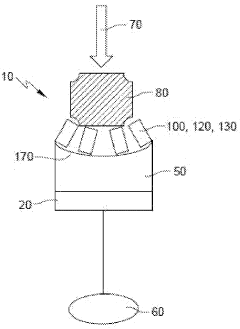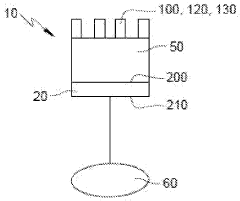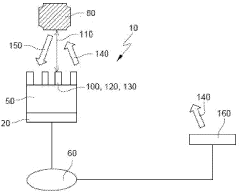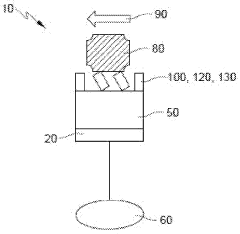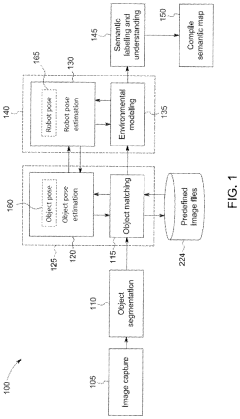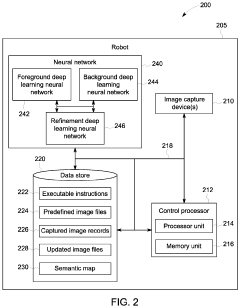Autonomous Robot Navigation Enhanced by Piezoelectric Sensors
JUL 17, 20259 MIN READ
Generate Your Research Report Instantly with AI Agent
Patsnap Eureka helps you evaluate technical feasibility & market potential.
Piezoelectric Sensors in Autonomous Navigation
Piezoelectric sensors have emerged as a promising technology for enhancing autonomous robot navigation systems. These sensors, which convert mechanical stress into electrical signals, offer unique advantages in detecting and measuring various environmental parameters crucial for robot navigation. The integration of piezoelectric sensors into autonomous navigation systems has been driven by the increasing demand for more precise, reliable, and efficient robot movement in complex environments.
The evolution of piezoelectric sensor technology in autonomous navigation can be traced back to early experiments in tactile sensing for robotic applications. Initially, these sensors were primarily used for obstacle detection and simple proximity sensing. However, as the technology matured, researchers began to explore more sophisticated applications, such as terrain mapping, vibration analysis for surface characterization, and even acoustic sensing for environmental awareness.
A significant milestone in this technological progression was the development of high-sensitivity piezoelectric materials and advanced signal processing techniques. These advancements allowed for the creation of more compact and versatile sensor arrays, capable of providing rich, multi-dimensional data about the robot's surroundings. The miniaturization of piezoelectric sensors also played a crucial role in their integration into various parts of robotic platforms, including wheels, legs, and body panels.
The current state of piezoelectric sensor technology in autonomous navigation is characterized by a focus on multi-modal sensing capabilities. Modern systems often combine piezoelectric sensors with other sensing technologies, such as cameras, LiDAR, and inertial measurement units (IMUs), to create a comprehensive environmental perception system. This integration allows robots to navigate with increased accuracy and adaptability across diverse terrains and conditions.
Looking ahead, the trajectory of piezoelectric sensor technology in autonomous navigation is poised for further innovation. Emerging research areas include the development of self-powered piezoelectric sensors, which could significantly enhance the energy efficiency of autonomous robots. Additionally, there is growing interest in leveraging machine learning algorithms to interpret complex piezoelectric sensor data, potentially enabling more nuanced and context-aware navigation decisions.
As the field continues to evolve, researchers and engineers are exploring novel applications of piezoelectric sensors in autonomous navigation. These include underwater navigation systems that utilize piezoelectric sensors for pressure and flow sensing, as well as aerial drones equipped with piezoelectric-based wind and turbulence detection capabilities. The ongoing advancements in materials science and nanotechnology are expected to yield even more sensitive and robust piezoelectric sensors, further expanding their potential in autonomous robot navigation systems.
The evolution of piezoelectric sensor technology in autonomous navigation can be traced back to early experiments in tactile sensing for robotic applications. Initially, these sensors were primarily used for obstacle detection and simple proximity sensing. However, as the technology matured, researchers began to explore more sophisticated applications, such as terrain mapping, vibration analysis for surface characterization, and even acoustic sensing for environmental awareness.
A significant milestone in this technological progression was the development of high-sensitivity piezoelectric materials and advanced signal processing techniques. These advancements allowed for the creation of more compact and versatile sensor arrays, capable of providing rich, multi-dimensional data about the robot's surroundings. The miniaturization of piezoelectric sensors also played a crucial role in their integration into various parts of robotic platforms, including wheels, legs, and body panels.
The current state of piezoelectric sensor technology in autonomous navigation is characterized by a focus on multi-modal sensing capabilities. Modern systems often combine piezoelectric sensors with other sensing technologies, such as cameras, LiDAR, and inertial measurement units (IMUs), to create a comprehensive environmental perception system. This integration allows robots to navigate with increased accuracy and adaptability across diverse terrains and conditions.
Looking ahead, the trajectory of piezoelectric sensor technology in autonomous navigation is poised for further innovation. Emerging research areas include the development of self-powered piezoelectric sensors, which could significantly enhance the energy efficiency of autonomous robots. Additionally, there is growing interest in leveraging machine learning algorithms to interpret complex piezoelectric sensor data, potentially enabling more nuanced and context-aware navigation decisions.
As the field continues to evolve, researchers and engineers are exploring novel applications of piezoelectric sensors in autonomous navigation. These include underwater navigation systems that utilize piezoelectric sensors for pressure and flow sensing, as well as aerial drones equipped with piezoelectric-based wind and turbulence detection capabilities. The ongoing advancements in materials science and nanotechnology are expected to yield even more sensitive and robust piezoelectric sensors, further expanding their potential in autonomous robot navigation systems.
Market Demand Analysis
The market demand for autonomous robot navigation enhanced by piezoelectric sensors is experiencing significant growth, driven by the increasing need for more efficient and precise robotic systems across various industries. This technology combines the advantages of autonomous navigation with the high sensitivity and versatility of piezoelectric sensors, creating a synergy that addresses multiple market needs.
In the manufacturing sector, there is a growing demand for robots capable of navigating complex factory environments with greater accuracy and adaptability. Piezoelectric sensor-enhanced navigation systems offer improved obstacle detection and real-time environmental mapping, which is crucial for optimizing production processes and ensuring workplace safety. This technology is particularly valuable in industries such as automotive, electronics, and aerospace manufacturing, where precision and flexibility are paramount.
The logistics and warehousing industry is another key market driver for this technology. With the rapid expansion of e-commerce and the need for more efficient supply chain management, there is an increasing demand for autonomous robots that can navigate warehouses and distribution centers with minimal human intervention. Piezoelectric sensors enable these robots to detect and avoid collisions more effectively, even in dynamic environments with moving objects and personnel.
In the healthcare sector, the market for autonomous navigation robots enhanced with piezoelectric sensors is growing due to the need for more sophisticated medical assistance and care delivery systems. These robots can navigate hospital corridors, patient rooms, and operating theaters with greater precision, ensuring safe and efficient movement of medical supplies, equipment, and even patients.
The agriculture industry is also showing increased interest in this technology. Autonomous robots equipped with piezoelectric sensors can navigate fields more accurately, performing tasks such as precision planting, crop monitoring, and harvesting with minimal damage to crops or soil. This technology addresses the growing need for sustainable and efficient farming practices in the face of labor shortages and increasing food demand.
The construction and infrastructure inspection markets are emerging areas of demand for this technology. Autonomous robots with enhanced navigation capabilities can perform inspections in hazardous or hard-to-reach areas, such as bridges, tunnels, and tall buildings, improving safety and efficiency in maintenance operations.
As urban environments become more complex, there is a rising demand for autonomous robots in smart city applications. These robots, equipped with advanced navigation systems, can perform tasks such as street cleaning, waste management, and security patrols more efficiently, contributing to improved urban living conditions.
The market for autonomous robot navigation enhanced by piezoelectric sensors is expected to continue its growth trajectory, driven by technological advancements, increasing automation across industries, and the need for more efficient and precise robotic systems. As the technology matures and becomes more cost-effective, its adoption is likely to accelerate, opening up new market opportunities and applications across various sectors.
In the manufacturing sector, there is a growing demand for robots capable of navigating complex factory environments with greater accuracy and adaptability. Piezoelectric sensor-enhanced navigation systems offer improved obstacle detection and real-time environmental mapping, which is crucial for optimizing production processes and ensuring workplace safety. This technology is particularly valuable in industries such as automotive, electronics, and aerospace manufacturing, where precision and flexibility are paramount.
The logistics and warehousing industry is another key market driver for this technology. With the rapid expansion of e-commerce and the need for more efficient supply chain management, there is an increasing demand for autonomous robots that can navigate warehouses and distribution centers with minimal human intervention. Piezoelectric sensors enable these robots to detect and avoid collisions more effectively, even in dynamic environments with moving objects and personnel.
In the healthcare sector, the market for autonomous navigation robots enhanced with piezoelectric sensors is growing due to the need for more sophisticated medical assistance and care delivery systems. These robots can navigate hospital corridors, patient rooms, and operating theaters with greater precision, ensuring safe and efficient movement of medical supplies, equipment, and even patients.
The agriculture industry is also showing increased interest in this technology. Autonomous robots equipped with piezoelectric sensors can navigate fields more accurately, performing tasks such as precision planting, crop monitoring, and harvesting with minimal damage to crops or soil. This technology addresses the growing need for sustainable and efficient farming practices in the face of labor shortages and increasing food demand.
The construction and infrastructure inspection markets are emerging areas of demand for this technology. Autonomous robots with enhanced navigation capabilities can perform inspections in hazardous or hard-to-reach areas, such as bridges, tunnels, and tall buildings, improving safety and efficiency in maintenance operations.
As urban environments become more complex, there is a rising demand for autonomous robots in smart city applications. These robots, equipped with advanced navigation systems, can perform tasks such as street cleaning, waste management, and security patrols more efficiently, contributing to improved urban living conditions.
The market for autonomous robot navigation enhanced by piezoelectric sensors is expected to continue its growth trajectory, driven by technological advancements, increasing automation across industries, and the need for more efficient and precise robotic systems. As the technology matures and becomes more cost-effective, its adoption is likely to accelerate, opening up new market opportunities and applications across various sectors.
Current Challenges in Robot Navigation
Autonomous robot navigation faces several significant challenges that hinder the widespread adoption and effectiveness of mobile robotic systems. One of the primary obstacles is the complexity of real-world environments, which often contain dynamic obstacles, uneven terrain, and unpredictable elements. These factors make it difficult for robots to accurately perceive and interpret their surroundings, leading to potential navigation errors and safety concerns.
Another major challenge is the limitation of current sensor technologies. While traditional sensors like LiDAR, cameras, and ultrasonic sensors provide valuable data, they often struggle in certain conditions such as low-light environments, reflective surfaces, or areas with electromagnetic interference. This can result in incomplete or inaccurate environmental mapping, compromising the robot's ability to navigate safely and efficiently.
The computational demands of real-time navigation pose another significant hurdle. Processing vast amounts of sensor data, performing simultaneous localization and mapping (SLAM), and making split-second decisions require substantial computing power. This challenge is particularly acute for smaller robots with limited onboard processing capabilities, potentially affecting their responsiveness and overall performance.
Energy efficiency remains a critical concern in autonomous robot navigation. The power consumption of multiple sensors, processors, and actuators can significantly limit the operational time of mobile robots, especially in applications requiring long-duration missions or deployment in remote areas with limited charging opportunities.
Adaptability to diverse environments presents another challenge. Robots designed for specific settings may struggle when faced with unfamiliar terrains or conditions. Developing navigation systems that can seamlessly adapt to various environments without extensive reprogramming or recalibration is an ongoing area of research and development.
The integration of ethical decision-making in navigation algorithms adds another layer of complexity. As robots increasingly operate in human-populated environments, they must be capable of making split-second decisions that prioritize human safety while still accomplishing their tasks efficiently. This requires sophisticated AI algorithms that can balance multiple objectives and adhere to ethical guidelines.
Lastly, the challenge of achieving true autonomy in complex, unstructured environments remains a significant hurdle. While robots can navigate effectively in controlled settings, developing systems that can handle the unpredictability and variability of real-world scenarios without human intervention is an ongoing pursuit in the field of robotics.
Another major challenge is the limitation of current sensor technologies. While traditional sensors like LiDAR, cameras, and ultrasonic sensors provide valuable data, they often struggle in certain conditions such as low-light environments, reflective surfaces, or areas with electromagnetic interference. This can result in incomplete or inaccurate environmental mapping, compromising the robot's ability to navigate safely and efficiently.
The computational demands of real-time navigation pose another significant hurdle. Processing vast amounts of sensor data, performing simultaneous localization and mapping (SLAM), and making split-second decisions require substantial computing power. This challenge is particularly acute for smaller robots with limited onboard processing capabilities, potentially affecting their responsiveness and overall performance.
Energy efficiency remains a critical concern in autonomous robot navigation. The power consumption of multiple sensors, processors, and actuators can significantly limit the operational time of mobile robots, especially in applications requiring long-duration missions or deployment in remote areas with limited charging opportunities.
Adaptability to diverse environments presents another challenge. Robots designed for specific settings may struggle when faced with unfamiliar terrains or conditions. Developing navigation systems that can seamlessly adapt to various environments without extensive reprogramming or recalibration is an ongoing area of research and development.
The integration of ethical decision-making in navigation algorithms adds another layer of complexity. As robots increasingly operate in human-populated environments, they must be capable of making split-second decisions that prioritize human safety while still accomplishing their tasks efficiently. This requires sophisticated AI algorithms that can balance multiple objectives and adhere to ethical guidelines.
Lastly, the challenge of achieving true autonomy in complex, unstructured environments remains a significant hurdle. While robots can navigate effectively in controlled settings, developing systems that can handle the unpredictability and variability of real-world scenarios without human intervention is an ongoing pursuit in the field of robotics.
Existing Piezoelectric Solutions
01 Piezoelectric sensors for navigation systems
Piezoelectric sensors are utilized in navigation systems to detect movement, orientation, and acceleration. These sensors convert mechanical stress into electrical signals, providing precise data for navigation purposes. They can be integrated into various navigation devices to enhance accuracy and reliability in determining position and direction.- Piezoelectric sensors for navigation systems: Piezoelectric sensors are utilized in navigation systems to detect and measure various parameters such as acceleration, vibration, and pressure. These sensors convert mechanical stress into electrical signals, providing accurate data for navigation purposes. The integration of piezoelectric sensors enhances the precision and reliability of navigation systems in various applications.
- Inertial navigation systems using piezoelectric technology: Inertial navigation systems incorporate piezoelectric sensors to measure acceleration and rotation. These systems use the data from piezoelectric sensors to calculate position, velocity, and orientation without external references. The high sensitivity and fast response of piezoelectric sensors make them ideal for accurate inertial navigation in various vehicles and devices.
- Piezoelectric sensors for underwater navigation: Piezoelectric sensors are employed in underwater navigation systems to detect acoustic signals and measure water pressure. These sensors enable accurate positioning and navigation in underwater environments where GPS signals are unavailable. The use of piezoelectric technology improves the performance of sonar systems and underwater vehicles.
- Integration of piezoelectric sensors with MEMS for navigation: Piezoelectric sensors are integrated with Micro-Electro-Mechanical Systems (MEMS) to create compact and highly sensitive navigation devices. This combination allows for the development of miniaturized inertial measurement units (IMUs) and accelerometers, which are crucial for navigation in small devices and unmanned vehicles.
- Energy harvesting for self-powered navigation sensors: Piezoelectric materials are used to harvest energy from vibrations and mechanical stress in navigation systems. This energy harvesting capability allows for the development of self-powered sensors, reducing the need for external power sources in navigation devices. The integration of energy harvesting with piezoelectric sensors enhances the autonomy and longevity of navigation systems.
02 Integration of piezoelectric sensors with GPS
Piezoelectric sensors are combined with GPS technology to improve navigation accuracy. This integration allows for more precise location tracking, especially in areas with weak GPS signals. The sensors provide additional data on movement and orientation, complementing GPS information for a more robust navigation system.Expand Specific Solutions03 Piezoelectric sensors for inertial navigation
Inertial navigation systems utilize piezoelectric sensors to measure acceleration and rotation. These sensors enable the calculation of position, velocity, and orientation without external references. This technology is particularly useful in environments where GPS signals are unavailable or unreliable, such as underwater or in space.Expand Specific Solutions04 Miniaturization of piezoelectric sensors for navigation
Advancements in piezoelectric sensor technology focus on miniaturization, allowing for integration into smaller navigation devices. These compact sensors maintain high sensitivity and accuracy while reducing power consumption. Miniaturized piezoelectric sensors enable the development of more portable and efficient navigation systems.Expand Specific Solutions05 Piezoelectric sensors for autonomous vehicle navigation
Piezoelectric sensors play a crucial role in autonomous vehicle navigation systems. They provide real-time data on vehicle dynamics, road conditions, and environmental factors. This information is used in conjunction with other sensors to enhance the accuracy and safety of autonomous navigation, particularly in challenging driving conditions.Expand Specific Solutions
Key Players and Competitors
The autonomous robot navigation market enhanced by piezoelectric sensors is in a growth phase, with increasing adoption across industries. The market size is expanding as more companies invest in developing advanced navigation systems. Technologically, while still evolving, piezoelectric sensor integration is showing promise in improving robot precision and adaptability. Key players like iRobot, Seiko Epson, and LG Electronics are driving innovation, leveraging their expertise in robotics and sensor technologies. Universities such as Zhejiang University and Nanjing University of Aeronautics & Astronautics are contributing significant research. The competitive landscape is diverse, with both established tech giants and specialized robotics firms vying for market share in this emerging field.
iRobot Corp.
Technical Solution: iRobot has developed an advanced autonomous navigation system for their robotic vacuum cleaners, incorporating piezoelectric sensors for enhanced obstacle detection and mapping. Their technology utilizes an array of piezoelectric sensors strategically placed around the robot's perimeter, providing high-resolution tactile feedback[1]. This allows for precise detection of obstacles, walls, and even small objects. The piezoelectric sensors work in conjunction with other sensors like cameras and LiDAR to create a comprehensive environmental awareness system. iRobot's navigation algorithm processes the multi-sensor data in real-time, enabling the robot to make quick decisions about path planning and obstacle avoidance[2]. The integration of piezoelectric sensors has significantly improved the robot's ability to navigate in complex home environments, reducing collisions and improving cleaning efficiency.
Strengths: Highly accurate obstacle detection, improved navigation in complex environments, and reduced collision rates. Weaknesses: Potential higher cost due to additional sensors, increased power consumption, and complexity in sensor data fusion.
Robert Bosch GmbH
Technical Solution: Bosch has developed an innovative autonomous navigation system that leverages piezoelectric sensors to enhance the capabilities of mobile robots and autonomous vehicles. Their approach integrates a network of high-sensitivity piezoelectric sensors with their existing suite of navigation technologies. These sensors are strategically placed to detect vibrations and pressure changes in the robot's environment, providing valuable tactile information that complements visual and spatial data from other sensors[9]. Bosch's system uses advanced signal processing techniques to interpret the piezoelectric sensor data, allowing for the detection of subtle environmental cues that might be missed by traditional sensing methods. This includes the ability to sense changes in surface texture, detect small obstacles, and even anticipate potential hazards based on micro-vibrations. The navigation algorithm developed by Bosch fuses this tactile information with data from cameras, LiDAR, and other sensors to create a comprehensive environmental model. This multi-modal approach enables more robust and adaptable navigation, particularly in challenging conditions such as low-light environments or on varying terrain[10].
Strengths: Enhanced environmental awareness, improved navigation in challenging conditions, and the ability to detect subtle environmental cues. Weaknesses: Increased system complexity, potential for sensor information overload, and higher costs associated with integrating multiple sensor types.
Core Innovations in Sensor Integration
PIEZOELECTRIC SENSOR TO DETECT DISTANCE, FORCE AND SLIDING OF AN OBJECT
PatentActiveFR3130966A1
Innovation
- A piezoelectric sensor comprising a piezoelectric plate with a transmitting element and a controller that measures force, detects sliding, and uses ultrasonic waves to determine distance, allowing for precise control of gripping forces and object positioning.
Systems and methods for autonomous robot navigation
PatentActiveUS11657506B2
Innovation
- A dense and semantic mapping system using prebuilt CAD models for object recognition and pose estimation, employing deep learning-based object segmentation and adversarial neural networks for accurate and fast object identification and localization, with iterative refinement and Kalman Filter-based optimization for improved accuracy and speed.
Regulatory Framework
The regulatory framework surrounding autonomous robot navigation enhanced by piezoelectric sensors is a complex and evolving landscape. As this technology intersects with various sectors, including transportation, healthcare, and industrial applications, it falls under the purview of multiple regulatory bodies and standards organizations.
In the United States, the National Highway Traffic Safety Administration (NHTSA) plays a crucial role in regulating autonomous vehicles, which may incorporate piezoelectric sensor-enhanced navigation systems. The NHTSA has issued guidelines for automated driving systems, emphasizing safety, cybersecurity, and human-machine interface considerations. These guidelines, while not specifically addressing piezoelectric sensors, provide a foundation for integrating such technologies into autonomous navigation systems.
The Federal Aviation Administration (FAA) has also established regulations for unmanned aerial vehicles (UAVs) that may utilize piezoelectric sensor-enhanced navigation. The FAA's Part 107 rules govern the commercial use of small UAVs, including requirements for registration, pilot certification, and operational limitations. As piezoelectric sensors become more prevalent in drone navigation systems, these regulations may need to be updated to address specific safety and performance concerns.
In the European Union, the General Data Protection Regulation (GDPR) has implications for autonomous robot navigation systems that collect and process personal data. Piezoelectric sensor-enhanced navigation may involve gathering environmental data that could potentially be linked to individuals, necessitating compliance with GDPR principles such as data minimization and purpose limitation.
The International Organization for Standardization (ISO) has developed several standards relevant to autonomous robot navigation, including ISO 13482:2014 for personal care robots and ISO 18646-2:2019 for performance criteria and related test methods for robot navigation. While these standards do not explicitly address piezoelectric sensors, they provide a framework for evaluating the safety and performance of navigation systems that may incorporate this technology.
As the field of autonomous robot navigation continues to advance, regulatory bodies are likely to develop more specific guidelines and standards for piezoelectric sensor-enhanced systems. This may include requirements for sensor accuracy, reliability, and resilience to environmental factors. Additionally, regulations may address the integration of piezoelectric sensor data with other navigation technologies, such as GPS and computer vision systems.
Manufacturers and developers working on autonomous robot navigation systems enhanced by piezoelectric sensors must stay informed about these evolving regulations and standards. Compliance with current and emerging regulatory frameworks will be essential for ensuring the safe and legal deployment of these advanced navigation technologies across various applications and industries.
In the United States, the National Highway Traffic Safety Administration (NHTSA) plays a crucial role in regulating autonomous vehicles, which may incorporate piezoelectric sensor-enhanced navigation systems. The NHTSA has issued guidelines for automated driving systems, emphasizing safety, cybersecurity, and human-machine interface considerations. These guidelines, while not specifically addressing piezoelectric sensors, provide a foundation for integrating such technologies into autonomous navigation systems.
The Federal Aviation Administration (FAA) has also established regulations for unmanned aerial vehicles (UAVs) that may utilize piezoelectric sensor-enhanced navigation. The FAA's Part 107 rules govern the commercial use of small UAVs, including requirements for registration, pilot certification, and operational limitations. As piezoelectric sensors become more prevalent in drone navigation systems, these regulations may need to be updated to address specific safety and performance concerns.
In the European Union, the General Data Protection Regulation (GDPR) has implications for autonomous robot navigation systems that collect and process personal data. Piezoelectric sensor-enhanced navigation may involve gathering environmental data that could potentially be linked to individuals, necessitating compliance with GDPR principles such as data minimization and purpose limitation.
The International Organization for Standardization (ISO) has developed several standards relevant to autonomous robot navigation, including ISO 13482:2014 for personal care robots and ISO 18646-2:2019 for performance criteria and related test methods for robot navigation. While these standards do not explicitly address piezoelectric sensors, they provide a framework for evaluating the safety and performance of navigation systems that may incorporate this technology.
As the field of autonomous robot navigation continues to advance, regulatory bodies are likely to develop more specific guidelines and standards for piezoelectric sensor-enhanced systems. This may include requirements for sensor accuracy, reliability, and resilience to environmental factors. Additionally, regulations may address the integration of piezoelectric sensor data with other navigation technologies, such as GPS and computer vision systems.
Manufacturers and developers working on autonomous robot navigation systems enhanced by piezoelectric sensors must stay informed about these evolving regulations and standards. Compliance with current and emerging regulatory frameworks will be essential for ensuring the safe and legal deployment of these advanced navigation technologies across various applications and industries.
Energy Harvesting Potential
Piezoelectric sensors in autonomous robot navigation systems offer a unique opportunity for energy harvesting, potentially enhancing the overall efficiency and operational duration of these robots. The energy harvesting potential of piezoelectric sensors stems from their ability to convert mechanical stress or vibrations into electrical energy. In the context of autonomous robots, this mechanical energy can be sourced from various movements and interactions with the environment during navigation.
The primary source of harvestable energy comes from the robot's locomotion. As the robot moves, its interactions with the ground or surface create vibrations and mechanical stresses that can be captured by strategically placed piezoelectric sensors. These sensors can be integrated into the robot's feet, wheels, or chassis, allowing for continuous energy generation during movement. The amount of energy harvested depends on factors such as the robot's weight, speed, and the nature of the terrain it traverses.
Another potential source of energy lies in the robot's interactions with obstacles or objects in its environment. Collisions, even minor ones, can generate significant mechanical stress that piezoelectric sensors can convert into electrical energy. While avoiding collisions is generally preferred for navigation, intentional light touches or controlled interactions with the environment could be designed to maximize energy harvesting without compromising the robot's primary functions.
Environmental vibrations present an additional opportunity for energy harvesting. Autonomous robots operating in industrial settings or urban environments are often exposed to ambient vibrations from machinery, traffic, or other sources. Piezoelectric sensors can capture these vibrations and convert them into usable energy, even when the robot is stationary.
The energy harvested through these methods can be used to supplement the robot's primary power source, potentially extending its operational time between charges. In some cases, it may even be possible to power low-energy components of the robot directly from the harvested energy, such as certain sensors or communication modules. This could lead to improved energy efficiency and reduced reliance on external charging.
However, it's important to note that the energy harvesting potential of piezoelectric sensors in autonomous robots faces some limitations. The amount of energy that can be harvested is typically small compared to the robot's overall energy requirements. Therefore, while it can contribute to improved energy efficiency, it is unlikely to completely replace traditional power sources in the near future. Additionally, the integration of energy harvesting systems must be carefully balanced against added weight and complexity, which could potentially impact the robot's performance and cost-effectiveness.
The primary source of harvestable energy comes from the robot's locomotion. As the robot moves, its interactions with the ground or surface create vibrations and mechanical stresses that can be captured by strategically placed piezoelectric sensors. These sensors can be integrated into the robot's feet, wheels, or chassis, allowing for continuous energy generation during movement. The amount of energy harvested depends on factors such as the robot's weight, speed, and the nature of the terrain it traverses.
Another potential source of energy lies in the robot's interactions with obstacles or objects in its environment. Collisions, even minor ones, can generate significant mechanical stress that piezoelectric sensors can convert into electrical energy. While avoiding collisions is generally preferred for navigation, intentional light touches or controlled interactions with the environment could be designed to maximize energy harvesting without compromising the robot's primary functions.
Environmental vibrations present an additional opportunity for energy harvesting. Autonomous robots operating in industrial settings or urban environments are often exposed to ambient vibrations from machinery, traffic, or other sources. Piezoelectric sensors can capture these vibrations and convert them into usable energy, even when the robot is stationary.
The energy harvested through these methods can be used to supplement the robot's primary power source, potentially extending its operational time between charges. In some cases, it may even be possible to power low-energy components of the robot directly from the harvested energy, such as certain sensors or communication modules. This could lead to improved energy efficiency and reduced reliance on external charging.
However, it's important to note that the energy harvesting potential of piezoelectric sensors in autonomous robots faces some limitations. The amount of energy that can be harvested is typically small compared to the robot's overall energy requirements. Therefore, while it can contribute to improved energy efficiency, it is unlikely to completely replace traditional power sources in the near future. Additionally, the integration of energy harvesting systems must be carefully balanced against added weight and complexity, which could potentially impact the robot's performance and cost-effectiveness.
Unlock deeper insights with Patsnap Eureka Quick Research — get a full tech report to explore trends and direct your research. Try now!
Generate Your Research Report Instantly with AI Agent
Supercharge your innovation with Patsnap Eureka AI Agent Platform!
